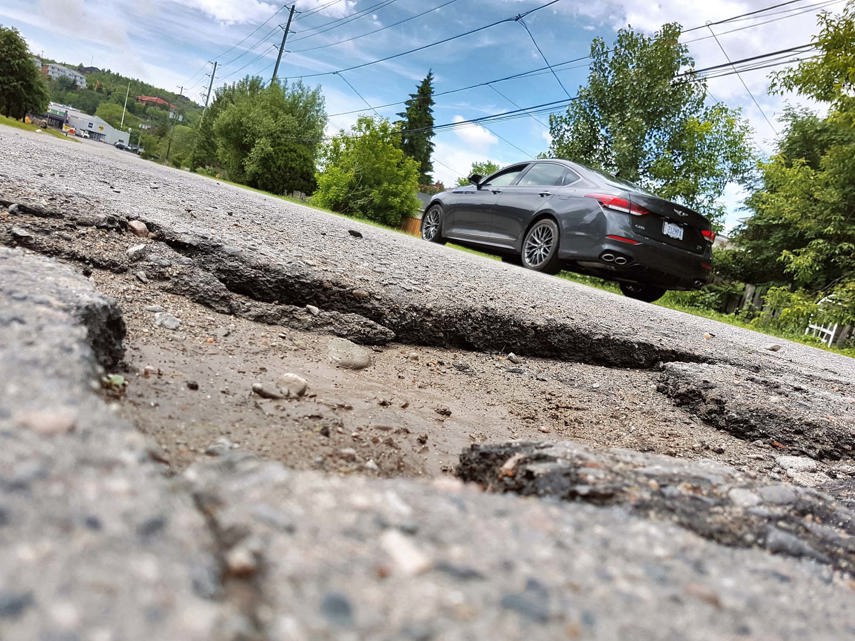I live in a city without potholes. JUST KIDDING! I live in Sudbury, Ontario, which is just the freaking worst. In fact, Sudbury seems to have multiple slots reserved perpetually in the annual CAA Worst Roads list, with numerous multi-year winners.
For most folks, most everywhere around the globe, potholes are an unfortunate fact of life. They lurk in wait, dotting roadways, popping up unexpectedly, scheming to bust your ball-joints, shatter your shocks, demolish your dampers, and blow great big chunks out of your tires and rims.
Should you be interested in understanding these most detestable of pavement imperfections, read on – we’ll have a look at where potholes are from, why they exist, what they can do to you ride, and what you can do about them.
The anatomy of a road

To understand how potholes work, it’s important to understand how roads work, first. Roads are simple: they consist of a layer of asphalt, a few inches thick, that rests on top of road bed, usually made of strategic layers of gravel and rock that’s built up, compacted, and levelled. The road bed sits on top of the earth beneath. If you sliced open a piece of roadway like a delicious birthday cake, you’d see a similar layering: a thin layer of asphalt (icing) on top of a much thicker layer of road bed (the cake itself), and all of that sitting on the ground beneath (the serving tray). Interestingly, nothing holds the asphalt to the surface of the road but its own weight. The gist? A road is a layer of asphalt that sits on top of layers of gravel and rock.
The recipe

To create a pothole, a few simple ingredients are needed. First, add some water, which finds its way into the roadbed, under the asphalt. Next, add some cold, which causes that water to freeze, and expand. Then, add some heat, melting the ice, and causing it to contract.
Repeat this many, many times, to weaken the roadbed with repeated freeze/thaw cycles, causing it to shift and settle and sag, which makes the asphalt on top crack. In turn, this makes it easier for water to enter the roadbed beneath. Next, add road salt to taste, which accelerates the freeze–thaw process further.
Finally, add traffic. This stresses the damaged asphalt and roadbed, causing pieces of pavement to be ejected (which allows more salt and water into the roadbed, to the further severity of the hole).
Let time take its course, and soon enough – ta-da! A delicious new pothole is now a thing that exists.
Fixing potholes

Fixing potholes properly can be difficult and expensive, since typically, doing it right requires removing a large portion of the asphalt around the offending crater, repairing the weakened roadbed beneath, applying new asphalt, and sealing the repair to prevent further water from leaking in. In some locales, including mine, technicians repair potholes by tossing cold asphalt mix into the still-wet chasm, smacking that mix a few times with a shovel, and moving on. This form of pothole repair lasts about 37 minutes, and partly explains why Sudbury has some of the worst-rated roads in the country (any why so many front-end shops in the city are so busy).
Repairing pothole damage

Clifford Danielson owns a front-end repair shop in Sudbury, Ontario. “Yup, this city’s roads make me an awful lot of money,” he says. “We see a lot of blown shocks, busted bushings, ball-joints, bent control arms, and the like. Tires take a lot of damage too – many potholes cause the sidewalls to crack, bubble, or even bust wide open. Hit a good pothole – and we have lots of them – and I’m typically going to make at least a few hundred dollars from you. We’re opening a wheel and tire shop to meet the demand for replacement rims and tires. In fact, we’re going to be a one-stop shop for when your ride gets mucked by a pothole! I love how much money this city’s roads make me, even if I have to be super careful when I’m driving my Lamborghini.”
Potholes nuke your suspension

Whack a pothole, and a variety of very bad things can happen underneath your ride. Shock absorbers can be damaged, causing bending, leaks, or total shock absorber failure. Tie-rod ends can also be bent or broken, as can control arms, which are vital suspension parts. The bushings associated with these components can also suffer damage, which will cause clunking and accelerated part wear, and will require replacement. A good pothole can even bend or crack your ride’s suspension control arms.
Ball joints are particularly vulnerable to pothole strikes. Especially if they’re already somewhat worn, a bad pothole can cause ball joint failure and separation, which can cause your car to lose a wheel, which isn’t much fun at all.
In any case, driving with a busted suspension is bad for your ride’s handling, performance and safety – so if you suspect a pothole has caused any damage, be sure to have it repaired as quickly as possible.
Potholes ruin your wheels and tires

Wheels and tires are some of the main casualties of potholes, and especially on sportier cars and crossovers with bigger wheels and thinner tires that lack the cushioning effect of a plump tire. Hit a good pothole in a ride like this, and one or more wheels and tires will be brutally murdered in an instant. Sidewalls can bubble, crack or burst, instantly leaving you with a flat tire that can’t be repaired. Wheels can crack, bend, or turn into an octagon, which will require replacement, and likely result in a flat. If you cream a giant pavement crater and your tire looks damaged but still holds air, you’ll want a mechanic to check it out right away, as it’s not safe to drive on, and can fail at any time.
Potholes can fudge your steering and alignment

Even if a pothole strike doesn’t produce any visible or instantly detectable damage, it may still be messing things up underneath your car. A good whack on a pothole can crack, bend or loosen suspension components, and throw your vehicle’s alignment out to lunch. This, in turn, wears your tires out faster, wastes gas, and makes your ride handle like a loaf of soggy bread. If you think your steering or handling feels funny after you hit a pothole, it probably does. Off to the shop you go. Bring your wallet.
What you can do about potholes

Two tips here. First, learn to play Guitar Hero. It’s a video game that requires players to anticipate large coloured dots streaming towards them from the top of their screen, in random patterns. You need to avoid certain dots, and to hit other ones. This video game can build the necessary hand-eye coordination, and forward vision, required for the successful navigation of an incoming field of craters with minimal damage. Just pretend the dots are potholes, and you’ll see what I mean.
Second, practice good driving skills. Sit upright in your seat, which makes it easier to keep your eyes up the road and to be aware of what’s going on in your surroundings. This can contribute to an easier time detecting potholes at a distance, and steering slightly to evade them without risk of hitting another motorist.
Finally, if a pothole strike is impending and unavoidable, apply as much braking as possible before you hit the pothole, and ease off of the brake pedal at the last possible moment. If you have to hit a pothole, you’re typically best to do it as slowly as possible, with no braking or throttle applied, and with the wheel pointed straight ahead.

